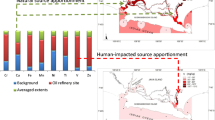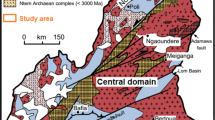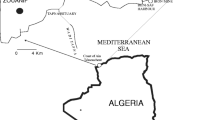Abstract
This study reports the concentrations of trace metals in core sediments profile from the coastal and four rivers estuary in the Kuching Division of Sarawak, Malaysia, and the controlling mechanisms influencing their availability in sediments of the studied area. The bonding of trace metals with non-mobile fractions was confirmed with the sequential extraction. Inductively coupled plasma–optical emission spectroscopy (ICP–OES) was used to measure the concentrations of the trace metals. Granulometric analyses were performed using normalized sieve apertures to determine the textural characteristics of the sediments. Enrichment factor was used to evaluate the level of metal enrichment. Heavy metals concentrations in sediment samples varied in the range: Pb (8.9–188.9 mg/kg d.w.), Zn (19.4–431.8 mg/kg d.w.), Cd (0.014–0.061 mg/kg d.w.), Ni (6.6–33.4 mg/kg d.w.), Mn (2.4–16.8 mg/kg d.w.), Cu (9.4–133.3 mg/kg d.w.), Ba (1.3–9.9 mg/kg d.w.), As (0.4–7.9 mg/kg d.w.), Co (0.9–5.1 mg/kg d.w.), Cr (1.4–7.8 mg/kg d.w.), Mg (68.8–499.3 mg/kg d.w.), Ca (11.3–64.9 mg/kg d.w.), Al (24.7–141.7 mg/kg d.w.), Na (8.8–29.4 mg/kg d.w.), and Fe (12,011–35,124.6 mg/kg d.w.). The estimated results of the enrichment factor suggested enrichments of Pb, Zn, and Cu in all the core sediment samples and depths at all sites. The other trace metals showed no enrichments in almost all the sampled stations. Continuous accumulation of Pb, Zn, and Cu metals over a period can be detrimental to living organisms and the ecology. The results obtained from the statistical analyses suggested that the deposition of trace metals in the studied sites is due to anthropogenic inputs from the adjacent land-based sources.
Similar content being viewed by others
Data availability
All data generated or analyzed during this study are included in this paper.
References
Agency for Toxic Substances and Disease Registry, ATSDR (2008) Toxicological profile for aluminum. US Department of Health and Human Services, Public Health Service, Atlanta
Alexakis D (2011) Diagnosis of stream sediment quality and assessment of toxic element contamination sources in East Attica, Greece. Environ Earth Sci 63:1369–1383
Alexakis D, Gamvroula D (2014) Arsenic, chromium, and other potentially toxic elements in the rocks and sediments of Oropos-Kalamos Basin, Attica, Greece. Appl Environ Soil Sci 718534:1–8
Alkarkhi AF, Ismail N, Ahmed A, Easa A (2009) Analysis of heavy metal concentrations in sediments of selected estuaries of Malaysia – a statistical assessment. Environ Monit Assess 153:179–185
Asare EA, Assim ZB, Wahi RB, Droepenu EK, Wilson F (2019a) Validation of the atomic absorption spectroscopy (AAS) for heavy metal analysis and geochemical exploration of sediment samples from the Sebangan River. Adv Anal Chem 9(2):23–33
Asare EA, Assim ZB, Wahi RB, Droepenu EK, Durumin Inya NM (2019b) Geochemistry examination of surface sediments from Sadong River, Sarawak, Malaysia: Validation of ICP-OES assessment of selected heavy metals. Eurasian J Anal Chem 14(3):9–20
Asare EA, Assim ZB, Wahi R (2021a) Validation of an analytical technique, distribution, and risk assessment of aliphatic and polycyclic aromatic hydrocarbons in surface sediments of the coastal and selected estuaries of Sarawak. Arab J Geosci 14:1943
Asare EA, Assim ZB, Wahi RB, Tahir RB, Droepenu EK (2021b) Application of fuzzy evaluation technique and grey clustering method for water quality assessment of the coastal and estuaries of selected rivers in Sarawak. Bull Natl Res Cent 45(1):1–11
Attia OEA, Ghrefat H (2013) Assessing heavy metal pollution in the recent bottom sediments of Mabahiss Bay, North Hurdhada, Red Sea. Egypt Environ Monit Assess 185(12):9925
Bale AJ, Kenny AJ (2008) Sediment analysis and seabed characterisation. In: Eleftherio A, McIntyre A (eds) Methods for the study of marine benthos. Blackwell Science Ltd, Oxford, pp 43–46
Bhuyan MS, Bakar MA, Rashed-Un-Nab M, Senapathi V, Chung SY, Islam MS (2019) Monitoring and assessment of heavy metal contamination in surface water sediment of the Old Brahmaputra River, Bangladesh. Appl Water Sci 9:125
Bodog I, Polyak K, Csikos-Hartyaanyi Z, Hlavay J (1996) Sequential extraction procedure for the speciation of elements in fly ashes samples. Microchem J 54(3):320–330
Buat-Menard P, Chesselet R (1979) Variable influence of the atmospheric flux on the trace metal chemistry of oceanic suspended matter. EPSL 42(3):399–411
Chen H, Teng Y, Lu S, Wang Y, Wang J (2015) Contamination features and health risk of soil heavy metals in China. Sci Total Environ 512–513:143–153
Chien LC, Hung TC, Choang KY, Yeh CY, Meng PJ, Shieh MJ, Han BC (2002) Daily intake of TBT, Cu, Zn, Cd and As for fishermen in Taiwan. Sci Total Environ 285(1–3):177–185
de Mora S, Fowler SW, Wyse E, Azemard S (2004) Distribution of heavy metals in marine bivalves, fish and coastal sediments in the Gulf and Gulf of Oman. Mar Pollut Bull 49(5–6):410–424
Decena SCP, Arguelles MS, Robel LL (2018) Assessing heavy metal contamination in surface sediments in an urban river in the Philippines. Pol J Environ Stud 27(5):1983–1995
Devesa-Rey R, Diaz-Fierros F, Barral MT (2011) Assessment of enrichment factors and grain size influence on the metal distribution in riverbed sediments (Anllons River, NW Spain). Environ Monit Assess 179:371–388
Dias-Ferreira C, Pato RL, Varejao JB, Tavares AO, Ferreira AJD (2016) Heavy metal and PCB spatial distribution pattern in sediments within an urban catchment – contribution of historical pollution sources. JSS 16:2594–2605
Ergonul MB, Altindag A (2014) Heavy metal concentrations in the muscle tissues of seven commercial fish species from Sinop Coasts of the Black Sea. Rocznik Ochrona Srodowiska 16(1):34–51
Eurachem, Middlesex (1998) The fitness for purpose of analytical methods: a laboratory guide to method validation and related.
Fakhradini SS, Moore F, Keshavarzi B, Lahijanzadeh A (2019) Polycyclic aromatic hydrocarbons (PAHs) in water and sediment of Hoor Al-Azim wetland, Iran: a focus on source apportionment, environmental risk assessment, and sediment-water partitioning. Environ Monit Assess 191:233
Farkas A, Erratico C, Vigano L (2007) Assessment of the environmental significance of heavy metal pollution in surficial sediments of the River Po. Chemosphere 68(4):761–768
Funk W, Dammann V, Donnevert G (2007) Quality assurance in analytical chemistry: applications in environmental, food and material analysis, biotechnology, and medical engineering. Wiley-VCH, Weinheim, Germany
Gao S (2019) Geomorphology and sedimentology of tidal flats. In: Perillo GME, Wolanski E, Cahoon DR (eds) CS Coastal Wetlands, 2nd edn. Elsevier, Amsterdam, pp 259–381
Gholizadeh A, Taghavi M, Moslem A, Neshat AA, Lari Najafi M, Alahabadi A, Ahmadi E, Ebrahimi Aval H, Asour AA, Rezaei H, Gholami S, Miri M (2019) Ecological and health risk assessment of exposure to atmospheric heavy metals. Ecotoxicol Environ Saf 184:109622
Gray J (1981) The ecology of marine sediments: an introduction to the structure and function of marine sediments. Cambridge Studies in Modern Biology, Cambridge, p 2
Guan Q, Wang F, Xu C, Pan N, Lin J, Zhao R, Yang Y, Luo H (2017) Source appointment of heavy metals in agricultural soil based on PMF: a case study in Hexi corridor, Northwest China. Chemosphere 193:189–197
Guo W, Wang Y, Shi J, Zhao X, Xie Y (2019) Sediment information on natural and anthropogenic-induced change of connected water systems in Chagan Lake, North China. Environ Geochem Health 42:795–808
Gupta SK, Chabukdhara M, Kumar P, Singh J, Bux F (2014) Evaluation of the ecological risk of metal contamination in river Gomti, India: a biomonitoring approach. Ecotoxicol Environ Saf 110:49–55
Hakanson L (1980) An ecological risk index for aquatic pollution control of sediment ecological approach. Water Res 14(8):975–1001
Hakanson L (1984) Aquatic contamination and ecological risk. An attempt at a conceptual framework. Water Res 18(9):1107–1118
Holme NA, McIntyre AD (1984) Methods for the study of marine benthos. Blackwell Scientific Publications, Oxford
Horowitz AJ, Elrick KA (1987) The relation of stream sediment surface area, grain size, and composition to trace element chemistry. J Appl Geochem 2(4):437–451
Ji H, Li H, Zhang Y, Ding H, Gao Y, Xing Y (2018) Distribution and risk assessment of heavy metals in overlying water, porewater, and sediments of Yongding River in a coal mine brownfield. JSS 18:624–639
Kanda A, Ncube F, Hwende T, Makumbe P (2018) Assessment of trace element contamination of urban surface soil at informal industrial sites in a low-income country. Environ Geochem Health 40:2617–2633
Kao S-J, Shiah F-K, Wang C-H, Liu K-K (2007) Efficient trapping of organic carbon in sediments on the continental margin with high fluvial sediment input off south western Taiwan. Cont Shelf Res 26(20):2520–2537
Kara M, Dumanoglu Y, Altiok H, Elbir T, Odabasi M, Bayram A (2015) Spatial variation of trace elements in seawater and sediment samples in a heavily industrialized region. Environ Earth Sci 73:405–421
Ke X, Gui S, Huang H, Zhang H, Wang C, Guo W (2015) Ecological risk assessment and source identification of heavy metals in surface sediments from the Liaohe River protected area, China. Chemosphere 175:473–481
Kowalska JB, Mazurek R, Gasiorek M, Zaleski T (2018) Pollution indices as useful tools for the comprehensive evaluation of the degree of soil contamination – a review. Environ Geochem Health 40(6):2395–2420
Li S, Zhang Q (2010) Spatial characterization of dissolved trace elements and heavy metals in the upper Han River (China) using multivariate statistical techniques. J Hazard Mater 176(1–3):579–588
Liang J, Feng C, Zeng G, Gao X, Zhong M, Li X, He X, Fang Y (2017) Spatial distribution and source identification of heavy metals in surface soils in a typical coal mine city, Lianyuan, China. Environ Pollut 225:681–690
Likuku AS, Mmolawa K, Gaboutloeloe GK (2013) Assessment of heavy metal enrichment and degree of contamination around the copper-nickel mine in the Selebi Phikwe region, Eastern Botswana. Environ Ecol Res 1:32–40
Lim PE, Kiu MY (1995) Determination and speciation of heavy metals in sediments of the Juru River, Penang, Malaysia. Environ Monit Assess 35:85–89
Liu J, Xiang R, Chen Z, Chen M, Yan W, Zhang L, Chen H (2013) Sources, transport and deposition of surface sediments from the South China Sea. Deep Sea Res Part I Oceanogr Res Pap 71:92–102
Maanan M, Saddik M, Maanan M, Chaibi M, Assobhei O, Zourarah B (2015) Environmental and ecological risk assessment of heavy metals in sediments of Nador lagoon, Morocco. Ecol Indic 48:616–626
Misa B, Darja K, Jakub K, Piotr S, Ewa B, Darinka BV (2014) Geochemical investigation of alluvial sediments: validation of ICP-OES determination of heavy metals. A case study from the Utrata River Valley (central Poland). Cent Eur J Chem 12(6):687–699
Monaci F, Bargagli R (1997) Barium and other trace metals as indicators of vehicle emissions. Water Air Soil Pollut 100:89–98
Morni WZW, Ab Rahim SAK, Rumpet R, Musel J, Hassan R (2017) Checklist of gastropods from the exclusive economic zone (EEZ), Sarawak. Malaysia Trop Life Sci Res 28(1):117–129
Muller G (1969) Index of geoaccumulation in sediments of the Rhine River. J Geol 2:108–118
Muller G (1979) Schwermetalle in den sediments des Rheins—Veranderungen Seitte. Umschan 78:778–783
Nawrot N, Matej-Łukowicz K, Wojciechowska E (2018) Change in heavy metals concentrations in sediments deposited in retention tanks in a stream after a flood. Pol J Environ Stud 28:1–6
Nawrot N, Wojciechowska E, Matej-Łukowicz K, Walkusz-Miotk J, Pazdro K (2020) Spatial and vertical distribution analysis of heavy metals in urban retention tanks sediments: a case study of Strzyza Stream. Environ Geochem Health 42:1469–1485
Nayak GN (2015) Bioavailability of metals in estuarine sediments and their possible impacts on the environment. Environ Social Sci 2:1–4
Nazeer S, Hashmi MZ, Malik RN (2016) Distribution, risk assessment, and source identification of heavy metals in surface sediments of River Soan, Pakistan. Clean - Soil, Air, Water 44(9):1250–1259
Omorinoye AO, Assim ZB, Jusoh IB, Durumin Iya NI, Asare EA (2019) Vertical profile of heavy metal contamination in sediments from Sadong River, Sarawak, Malaysia. Indian J Environ Prot 39(11):971–978
Omorinoye AO, Assim ZB, Jusoh IB, Durumin Iya NI, Bamigboye OS, Asare EA (2020) Distribution and sources of aliphatic hydrocarbons in sediments from Sadong River, Sarawak, Malaysia. Res J Chem Environ 24(6):70–77
Pandey J, Singh R (2015) Heavy metals in sediments of Ganga River: up-and downstream urban influences. Appl Water Sci 7:1669–1678
Saleem MH, Rahman M, Kamran M, Afzal J, Armghan N, Liu L (2020) Investigating the potential of different jute varieties for phytoremediation of copper-contaminated soil. Environ Sci Pollut Res 27:30367–30377
Salomons W, Forstner U (1984) Metals in the hydrocycle. Springer, Berlin
Sekabira K, Oryem Origa H, Basamba TA, Mutumba G, Kakudidi E (2010) Assessment of heavy metal pollution in the urban stream sediments and its tributaries. IJEST 7:435–446
Shaari H, Mohamad Azmi SNH, Sultan K, Bidai J, Mohamad Y (2015) Spatial distribution of selected heavy metals in surface sediments of the EEZ of the east coast of Peninsular Malaysia. Int J Oceanogr 2015:618074
Silveira A Jr, Pereira JA, Poleto C, de Lima JLMP, Goncalves FA, Alvarenga LA et al (2016) Assessment of loose and adhered urban street sediments and trace metals: a study in the city of Poc¸os de Caldas, Brazil. JSS 16:2640–2650
Sim SF, Ling TY, Nyanti L, Gerunsin N, Wong YE, Kho LP (2016) Assessment of heavy metals in water, sediment, and fishes of a large tropical hydroelectric dam in Sarawak, Malaysia. J Chem 2016:8923183
Sim HC (2007) Urbanization in Sarawak: a context.
StatSoft, (1999) STATISTICA for windows. Computer Programme Manual, Tulsa
Tian K, Huang B, Xing Z, Hu W (2017) Geochemical baseline establishment and ecological risk evaluation of heavy metals in greenhouse soils from Dongtai, China. Ecol Indic 72:510–520
Tiana K, Wua Q, Liua P, Hua W, Huanga B, Shid B, Zhou Y, Kwon B, Choi K, Ryu J, Khim JS, Wang T (2020) Ecological risk assessment of heavy metals in sediments and water from the coastal areas of the Bohai Sea and the Yellow Sea. Environ Int 136:105512
Turekian KK, Wedepohl KH (1961) Distribution of the elements in some major units of the earth’s crust. Geol Soc Am Bull 72(2):175–192
United State Environmental Protection Agency, USEPA (2009) Risk-based concentration table. United States Environmental Protection Agency, Philadelphia PA
United State Environmental Protection Agency, USEPA (2007). Procedure for determination of sediment particle size (grain size), 73505.
Wang Y, Yang L, Kong L, Liu E, Wang L, Zhu J (2015) Spatial distribution, ecological risk assessment and source identification for heavy metals in surface sediments from Dongping Lake, Shandong, East China. CATENA 125:200–205
Wang J, Liu G, Lu L, Liu H (2016) Metal distribution and bioavailability in surface sediments from the Huaihe River, Anhui. China Environ Monit Assess 188:3
Wang H, Sun L, Liu Z, Luo Q (2017) Spatial distribution and seasonal variations of heavy metal contamination in surface waters of Liaohe River, Northeast China. Chin Geogr Sci 27:52–62
Wang L, Li H, Dang J, Zhao Y, Zhu Y, Qiao P (2020) Effects of urbanization on water quality and the macrobenthos community structure in the Fenhe River, Shanxi Province, China. J Chem 2020:1–9
Weissmannova HD, Pavlovsky J (2017) Indices of soil contamination by heavy metals – methodology of calculation for pollution assessment (minireview). Environ Monit Assess 189:616
Weissmannova HD, Pavlovsky J, Chovanec P (2015) Heavy metal contaminations of urban soils in Ostrava Czech Republic: assessment of metal pollution and using principal component analysis. Int J Environ Res 9(2):683–696
Wen J, Yi Y, Zeng G (2016) Effects of modified zeolite on the removal and stabilization of heavy metals in contaminated lake sediment using BCR sequential extraction. J Environ Manage 178:63–69
Wu B (2014) Potential ecological risk of heavy metals and metalloid in the sediments of Wuyuer River basin Heilongjiang Province, China. Ecotoxicology 23:589–600
Xu J, Xu L, Zheng L, Liu B, Liu J, Wang X (2019) Distribution, risk assessment, and source analysis of heavy metals in sediment of rivers located in the hilly area of southern China. JSS 19:3608–3619
Yang Y, Chen F, Zhang L, Liu J, Wu S, Kang M (2012) Comprehensive assessment of heavy metal contamination in the sediment of the Pearl River Estuary and adjacent shelf. Mar Pollut Bull 64(9):1947–1947
Yang J, Ma S, Zhou J (2018) Heavy metal contamination in soils and vegetables and health risk assessment of inhabitants in Daye. China J Int Med Res 46(8):3374–3387
Zarei I, Pourkhabbaz A, Khuzestani RB (2014) An assessment of metal contamination risk in sediments of Hara Biosphere Reserve, southern Iran with a focus on the application of pollution indicators. Environ Monit Assess 186:6047–6060
Acknowledgements
The authors acknowledge the contribution of colleagues from the Analytical Chemistry Laboratory, Faculty of Resource Science and Technology (FRST), Universiti Malaysia Sarawak.
Funding
The consumables and field trip cost of the entire research were financially supported by Universiti Malaysia Sarawak, Postgraduate Research Grant, with Grant Code: F07/PGRG/1896/2019.
Author information
Authors and Affiliations
Contributions
EAA, ZA, and RW conceived of the study and carried out the design of the experiment. EAA and ZA carried out the sample preparation and analysis; EAA, TB, and SSD assessed the data; and EAA, ZA, and RW helped to draft and edited the manuscript. The author(s) read and approved the final manuscript.
Corresponding author
Ethics declarations
Competing interests
The authors declare no competing interests.
Additional information
Communicated by V.V.S.S. Sarma.
Publisher's Note
Springer Nature remains neutral with regard to jurisdictional claims in published maps and institutional affiliations.
Supplementary Information
Below is the link to the electronic supplementary material.
Rights and permissions
About this article
Cite this article
Asare, E., Assim, Z., Wahi, R. et al. Trend analysis of anthropogenic activities affecting trace metals deposition in core sediments from the coastal and four rivers estuary of Sarawak, Malaysia. Environ Sci Pollut Res 29, 16294–16310 (2022). https://doi.org/10.1007/s11356-021-17008-1
Received:
Accepted:
Published:
Issue Date:
DOI: https://doi.org/10.1007/s11356-021-17008-1









